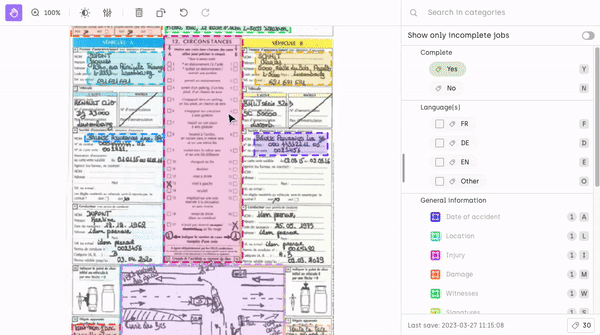March 30th, 2023
over 2 years ago by Kili Technology
Changelog (v2.130.0)
New
- [Labeling] In the jobs viewer, you can now use the Show only incomplete jobs filter to list all the required annotation jobs that have not been completed yet. Additionally, if you click Submit on an asset with incomplete required jobs, this filter gets automatically switched on. This way you’ll never miss a required job again, which will help save some of the precious reviewers’ time.

- [Labeling] When many annotations are shown in the asset viewer at the same time, it may be difficult to add new ones, because the details of the asset get occluded. That’s why we’ve added
opacityin the annotation display settings. When you lower the opacity for visible annotations, you’ll be able to add new ones with extra precision.

- [Labeling] In Video projects, you can now resize the frame player to assign more screen space to the video that you’re annotating. More space means fewer details missed and increased labeling quality.
- [Org management] The Metrics page has been replaced by Usage & License where you can find the details of your license and your usage metrics. To access it, click on your name in the top-right corner of the screen and from the menu that opens, select Manage organization. For more information, refer to our documentation.
This feature will be rolled out progressively in following days after March 30th.

- [Org management] An org admin can now remove a user from a project directly from the list of projects the user has access to. If you’re managing many projects and users at once, this will help you speed up and streamline the whole process.
Changed
- [Labeling] We’ve changed the cursor that is displayed when you copy geo coordinates of GeoTiff assets, to enable you to capture these coordinates with more precision. To quickly access this tool, you can now use the Option/Alt + C shortcut.

- [Labeling] Because transcription tasks sometimes require adding large chunks of text, we’ve made these fields resizable. This will make the process easier and more intuitive. To resize a text input field, simply drag its bottom-right corner.

- [Labeling] When creating a polygon, you can now remove the point that was added last by pressing Command/Control + Z. Then simply continue drawing the polygon’s shape, without losing focus on your current task.
- [Labeling] When labelers add several instances of the same annotation class, Kili automatically appends consecutive ordinal numbers to the annotations (for example
person 1,person 2etc.). Up to now, the video interface used to be an exception: numbered annotations were not being shown in the video timeline (in our example case, the timeline would only show several instances ofperson), which could have been confusing. From now on, the names of the annotations visible in the timeline will be the same as the ones visible in the job viewer. We’ve also changed the default behavior when these annotations are deleted. Before the change, the ordinal numbers would get re-assigned each time an annotation was deleted. Now, there’s no re-assignment. Both of these changes should eliminate some confusion when labeling, thus boosting your quality metrics. - [Python SDK] In SDK documentation, the tutorials list now has its own separate tab in the main menu, for better discoverability. Also: we’ve grouped the tutorials into easily-understandable categories.
- [Python SDK] When you call these methods with an empty input list, you will now get a warning and the method will return immediately:
kili.append_many_to_dataset()kili.update_properties_in_assets()kili.change_asset_external_ids()kili.delete_many_from_dataset()kili.add_to_review()kili.send_back_to_queue()
Fixed
- [Labeling] While working on a segmentation task it was not possible to drag the image using the Space key. We’ve fixed this issue.
- [Labeling] Adding annotations by using the interactive segmentation tool sometimes resulted in an additional point and a dashed line being added on screen. We’ve fixed this issue.
- [Exporting] In projects with remotely-hosted assets, exporting from the front-end caused exports to fail because the Kili app was trying to add remotely-hosted assets in the zip file. We’ve fixed this: when your project is using remotely-hosted assets, only labels are included in the archive, not the files.
- [Python SDK] In the method for exporting to the COCO format, we’ve added a new option:
layout=merged. If you use this option, all the annotations of all the jobs will be exported into a single file. This is useful in situations when you initially converted your label categories into separate labeling jobs and now you want to merge them and use them as the input of an ML model.